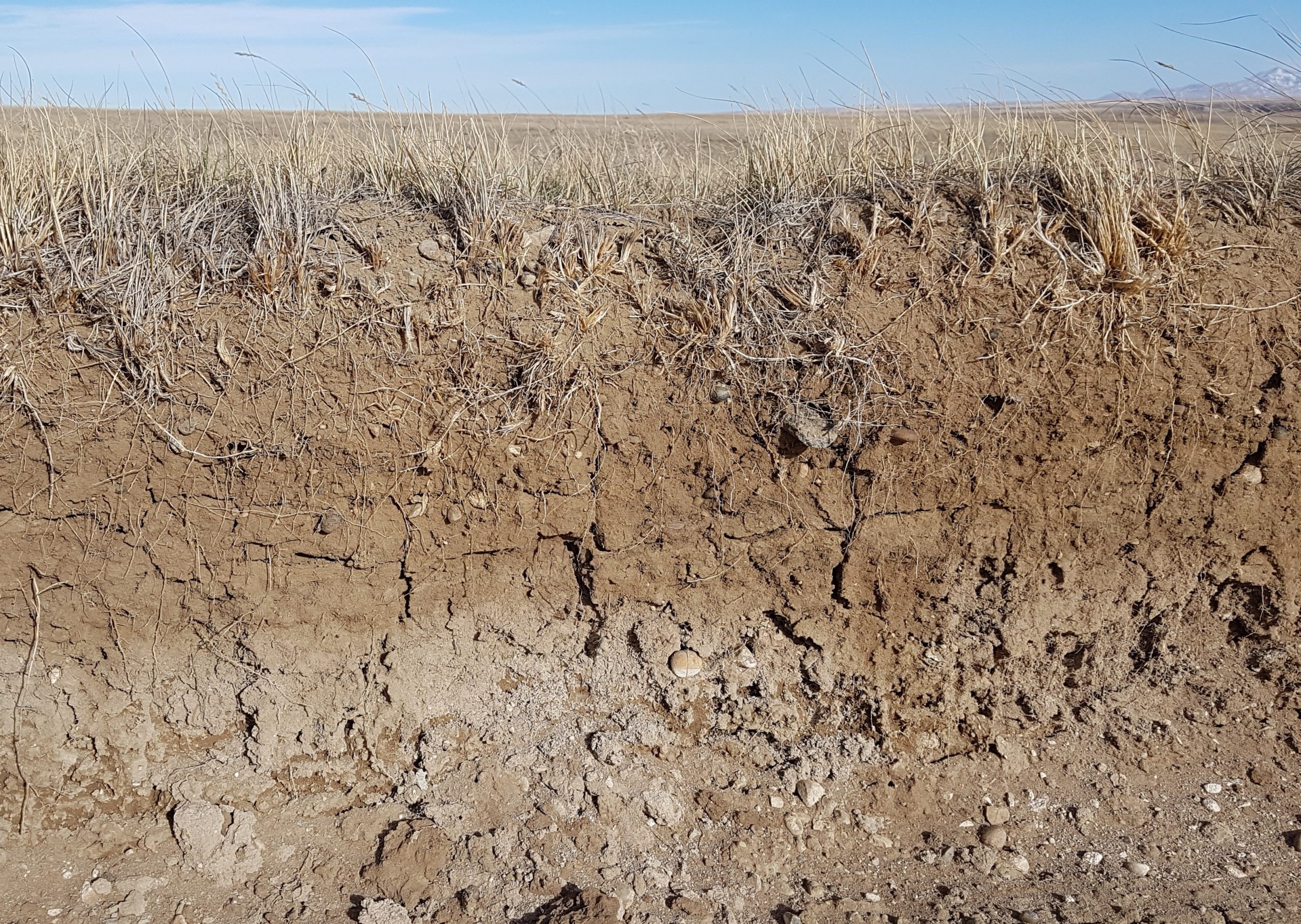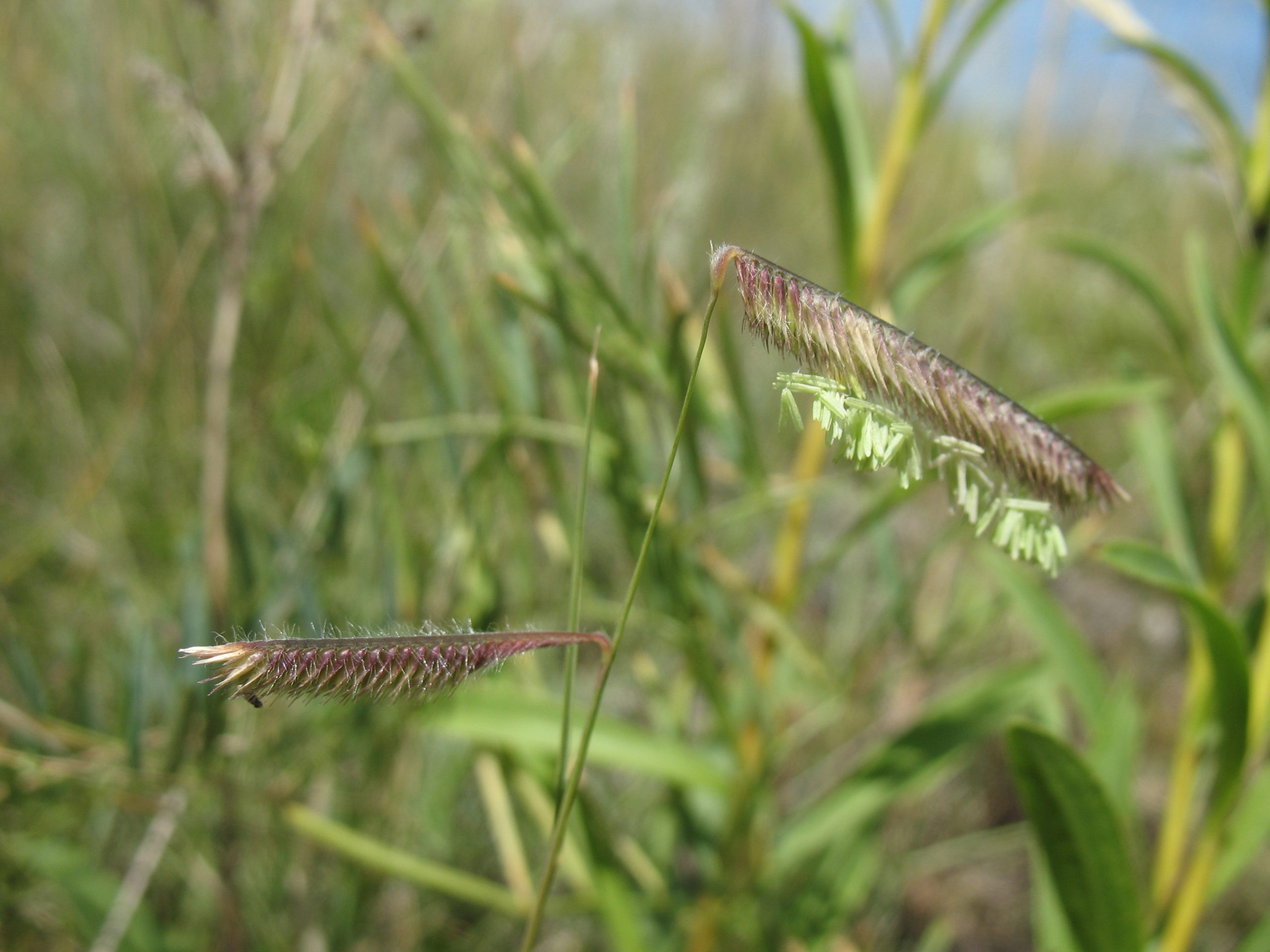

Survival in Drought
April 10, 2024
- •
- •
- •
Without a substantial amount of spring rain, the prairies can look forward to another hot and dry summer.

A wheatgrass-dominated plant community, as with many prairie communities, has extensive fibrous roots reaching below the soil. These root systems improve water infiltration and can extend far below the soil surface, effectively finding and drawing water. Many plants also form mycorrhizal associations, further extending the reach of roots and improving access to water and nutrients. Photo © J. Lancaster
By Ruiping Luo
Read the pdf version here.
The word “drought” is everywhere lately. After a warm winter, and with much less snow than usual, rivers are low, and reservoirs are depleted. Without a substantial amount of spring rain, the prairies can look forward to another hot and dry summer, and these droughts are only expected to become more frequent and severe as the world warms.
Still, droughts are not unknown on the prairies, with their position in the middle of the continent and far from the humid ocean winds. Especially during long summer days, when the sun blazes for 16 hours in a cloudless sky, and dry winds steal away every drop they can reach, water quickly becomes scarce. For the plants growing in this severe environment, drought can be a natural occurrence.
To survive, prairie plants have developed traits and strategies that let them flourish despite the dry conditions. There are still many mysteries hidden in these plants, and we are only just beginning to discover all the fascinating traits these species have developed, from individual physiology to the communities they build that persist in a challenging climate.
First Impressions
The most visible adaptation is in the leaves. Long and narrow, this shape is assumed by many prairie plants, as it reduces the surface area exposed to sun and wind. Evaporation of water increases with surface area, so this shape also helps to minimize water loss from plants. Grasses, which dominate these lands, have mastered this shape, forming long blades that bend easily in the fierce gales, as well as retaining water through the dry season.
Forbs and shrubs, which produce broader leaves, have other strategies to prevent their desiccation, or drying out. For instance, a waxy coating can help to seal water inside the leaf, and additionally acts as a protective layer against pests and diseases. Some plants are covered with tiny hairs, giving the plant a silvery appearance. These hairs reflect sunlight and reduce wind speed at the leaf surface — two factors that increase evaporative water loss — to create a microclimate that retains moisture at the leaf surface. By reducing evaporation from the leaf, prairie plants can conserve water in hot and dry conditions.

Blue grama grass (Bouteloua gracilis), a drought-tolerant native grass, has narrow leaves that are often twisted and curled, reducing the sun and wind exposure, and evaporative water loss. It also has deep roots, on average two to three times longer than the height of the plant, and produces light seeds easily carried by the wind. Photo © J. Hildebrand
Plants also lose a significant amount of water through their stomata, openings on the leaf surface that are used for gas exchange. When stomata are open, plants receive carbon dioxide and release oxygen, though they also release precious water. Plants can close the stomata to save water, although, without the supply of carbon dioxide, photosynthesis — a process vital to plant survival — is severely limited. To restrict water loss through their stomata, some prairie plants have leaves that fold or curl inward to shield stomata. This helps to reduce direct sun exposure and cool the leaf, as well as block wind, lessening water loss from the leaf.
More than reducing water loss, plants need to reach water when soils dry. For this, plants rely on their roots. Prairie plants are well-known for their large root systems, often two or three times as deep as the plant is high, with some reaching over three metres belowground. In grasses, thin yet extensive fibrous roots spread across the land, quickly and efficiently absorbing any water it encounters. Other plants rely on deep taproots, able to penetrate far into the soil and reach water that has retreated from the upper layers. Through their taproots, plants can draw moisture to the surface, where it is needed. These roots also help to anchor the plant in soil, preventing the organism being blown or washed away in the constantly changing prairie.
Acclimatization
The impressive root systems of prairie plants mean most plant biomass is stored underground. So, any injury to shoots and leaves — for instance, from heat or fire — misses a majority of the plant, and most plants can survive the damage. In times of severe and extended drought, some plants survive by becoming dormant, letting their leaves die back and using energy already stored in their roots, waiting until conditions are more favourable.
Prairie plants also have growing points, from which the plant propagates, below or at the soil surface. This means that growing points are protected from heat, wind, and most fires. Once the threat has passed, plants can quickly regrow shoots and leaves. In this way, leaves that withered during droughts can be replaced as soon as water is available again, and even after intense drought, the prairie can recover.
For some prairie inhabitants, one strategy to deal with drought is avoidance. For instance, cool-season grasses, which begin growing in late winter, will usually have flowered, and produced seeds by early summer. By late summer, these grasses have gone dormant, avoiding the worst of the heat and drought. Some plants will produce seeds and die before the dry summer arrives, leaving their hardier seeds to survive the water shortage and sprout the next spring. Similarly, even warm-season plants, which normally flower in late summer or early fall, may flower earlier during extended droughts, ensuring that at least some seeds are produced and can survive until rain returns.
Chemistry
Plant biochemistry also plays an important role in allowing plants to survive drought. For instance, plants may produce osmoprotectants, chemical compounds that help cells retain water in very dry conditions. Water can also be stored in taproots and stems, sometimes as sap. Succulents, a group highly adapted to dry conditions, also have specialized parenchyma cells that are adapted to hold water.

Plants of the prairie community cooperate to survive drought and other climatic extremes, provide food and shelter for a range of other prairie species, and create a resilient ecosystem. Photo © L. Wallis
Photosynthesis can also impact drought survival. There are two main photosynthetic pathways that prairie plants use, known as the C3 and C4 pathways. Globally, more plants use the C3 pathway, which requires fewer resources and can be more successful in moist and cool environments. The cool-season grasses of the prairies mainly use C3 photosynthesis, which allows them to better tolerate the cold early spring conditions and grow rapidly, completing their life cycle before summer.
In contrast, many of the warm-season grasses use C4 photosynthesis. C4 plants work by building up high concentrations of carbon dioxide in chloroplasts, improving the efficiency of photosynthesis. They can store some carbon at night when temperatures are cooler and use this carbon for photosynthesis during the day. As a result, C4 plants can continue photosynthesis even with their stomata partially or fully closed, greatly reducing water loss through the stomata.
Community
More than their individual adaptations, these plants must cooperate to create a landscape that can endure the summer drought. Cooperation begins with their roots, which not only allow the plant to reach water hidden deep belowground but also helps to aerate soil and prevent compaction. Through these actions, the extensive prairie root system encourages water infiltration, allowing more water to be stored in soil rather than being lost over the land as runoff.
Roots, especially taproots, can further help to relocate water. Through a process known as hydraulic redistribution, water travels through roots from wet to dry areas. So, after rainfall, when more water is at the soil surface, roots help to carry water into deeper soil, where it is stored. During drought, when the top layers of soil begin to dry, long taproots can carry water from deeper, wetter soil back to shallower, drier soil, where more shallow-rooted plants can access water. Fibrous root systems can quickly and efficiently absorb excess water, reducing loss of soil moisture to evaporation and runoff. In this way, species with different types of roots can work together to relocate and use water effectively during drought.
Both types of roots are vital for providing soil structure. The intertwined and extensive root systems of prairie species anchor soil. Tiny hairs on some roots cling to soil particles, shielding them from wind and water erosion. The soil, in turn, protects plant roots from wind, sun and other environmental hazards and provides the essential nutrients plants need to grow.
The soil is also home to a variety of other organisms, including microbes that play a role in drought tolerance. Soil microbes help build soil organic matter, a component that helps to hold water and increase soil moisture, as well as contributing to soil structure. Many prairie plants also have mycorrhizae associations, symbiotic associations between plants and fungi. In exchange for carbon from the plant, mycorrhizae can transfer nutrients and water to the plant. During drought, the expanded area of mycorrhizae may contribute to finding and absorbing water into root systems, bolstering plant performance and survival.
Beyond the soil and microbes, plants anchor much of the prairie community, and many of these organisms respond in a way that boosts plant health. For instance, they keep the soil together for larger insects, including dung beetles. In turn, these beetles tunnel through the soil, improving soil aeration, water retention and nutrition. Pollinators, many of which depend on these plants for nectar, are critical for the seed production that allows these plants to reestablish after the drought has passed. The persistence of these plants through the harshest droughts is central to the survival of the grassland ecosystem and many of the species that rely on it.
Invaders
Yet the prairie community is under attack. Conversion and development have fragmented the landscape, and with these changes, invaders have transformed the prairie. These invaders may thrive during the wet seasons, especially with human assistance. However, they lack the generations of evolution that native plants have endured, and the many adaptations that allow them to survive through heat and drought.
For instance, Kentucky bluegrass (Poa pratensis), a grass common to garden lawns, can grow up to 30 centimetres tall, though most of the roots were found to be in the top 15 to 25 centimetres of soil, far shallower than the several metres deep that native plant roots can reach. This species also has a high evapotranspiration rate, losing water easily through leaves, and the roots do not retain water well. Without a sufficient water supply, these invasive plants are likely to perish, leaving the soil bare and subject to erosion.
Over millions of years, the prairie ecosystem adapted to survive drought. The ecosystem has persevered through countless dry years, though now the grasslands are facing new threats, in the fragmentation of the open plains, the invasive species that are seizing the environment, and the increasingly common and severe droughts that drain the landscape. Still, compared to non-native species, this community is best prepared to survive the coming summer, and we may yet need to rely on the native plants to endure the anticipated droughts.
